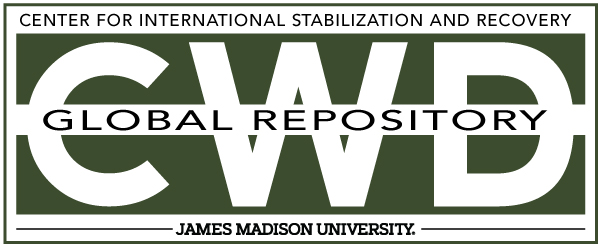Document Type
Other
Creative Commons License

This work is licensed under a Creative Commons Attribution-Noncommercial-No Derivative Works 4.0 License.
Publication Date
11-2001
Keywords
TWEIS, 2001, 3rd Edition, Risk Education, Victim Assistance, ERW Clearance, Conventional Weapons Stockpile Destruction, Advocacy and International Law, Centers and Organizations, State Department, Humanitarian Mine Action, Landmine, Clearance, Victim Assistance, Risk Education, Funding, PM/WRA, MANPADS, HMA, Training, Research, Development, PSSM, CISR
Abstract
The United States first became involved in humanitarian demining in 1988 when it sent a team to assess the landmine situation in Afghanistan. Five years later, U.S. demining-related programs were underway in Afghanistan and seven other countries. By the end of 2001, we will have provided more than $500 million to 38 countries, as well as the Province of Kosovo and northwest Somalia, for various humanitarian demining efforts such as deminer training, mine awareness and mine clearance, as well as orthopedic assistance to, and socioeconomic reintegration programs for, landmine accident survivors and their families. Almost $100 million of this amount will be spent in Fiscal Year (FY) 01, the largest commitment of any nation involved in financing humanitarian demining activities. The list of recipients of U.S. humanitarian demining assistance is expected to grow in 2002. As a result of our assistance, and that of other donor nations, the world is seeing positive results in many mine-affected countries' reduced casualties, restored agricultural and pastoral land, the return of refugees and internally displaced persons (IDP) to their homes, reopened roads, schools, and markets, and other visible evidence of a return to a productive life.
The goals of the U.S. humanitarian demining program are simple and direct: to reduce the loss of life and limb of innocents; to create conditions for the safe return of refugees and IDP; and to afford opportunity for economic and social reconstruction. Our principal means of achieving these objectives is to assist mine-afflicted countries worldwide in establishing a sustainable, indigenous demining capacity with the appropriate resources and skills needed to sustain progress toward a country declaring itself mine-safe.
This, the 3rd edition of To Walk the Earth in Safety: The United States Commitment to Humanitarian Demining, tells the U.S. story, but not the whole story. Foreign governments, the United Nations, other international and nongovernmental organizations (NGO), and mine-affected countries also play a critical role in supporting humanitarian demining programs. The impact of these collective contributions is felt in many mine-affected countries. Moldova declared itself mine-safe in March 2001. In the near future, several other countries likely will also declare themselves mine-safe.
The success stories in this publication attest to the United States Government's belief that when we assist other countries in meeting needs such as clearing landmines, we are serving America's long-term interest and staying true to America's permanent values. The U.S. Humanitarian Demining Program, like our other assistance efforts, is more than foreign aid; these programs aid America, too. Our assistance helps define America's role in the world, often contributing to the economic well-being of our own citizens and those of other countries, and advances our interest in peace, stability, and freedom abroad.
Included in
Defense and Security Studies Commons, Peace and Conflict Studies Commons, Public Policy Commons, Social Policy Commons



